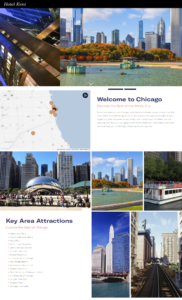When you review the SEO performance of your hotel’s website, are you happy with the results? If you are failing to rank for many of your targeted keywords, the source of your issues may be thin on-page content. In order to achieve a successful digital marketing strategy, thin and weak content must be avoided at all cost and improved wherever it exists.
How A Panda Changed the Internet
Back in 2011, Google rolled out an update to their algorithm by the name of “Google Panda.” Panda caused an upheaval in the SEO world, and many of the practices that emerged as a result are still considered standards for SEOs today. Google regularly makes new updates to their ranking algorithm, and the changes made by Panda are still a major determining factor between what ranks on the first page of their results and what does not.
Google Panda primarily addressed the issue of thin, low quality content on websites. Many large scale brands still worry about the effect thin and duplicate content has on their sites, and they take careful (sometimes drastic) steps to avoid it.
“What is thin content and how can we avoid it?” still comes up with many Blue Magnet clients today. Thin content – and duplicate content – are issues that relate heavily to the quality and helpfulness of the information on your website and need to be addressed when working on a hotel’s independent website.
Google had a very good reason for targeting and penalizing sites with thin and duplicate content. Back in the early 2000’s, many websites were using short, spammy pages to quickly reach the top of search results without putting forth much effort to provide valuable information for users. By updating their algorithm to prefer robust and unique content that fulfills searcher intent, the big brains over at Google made it more difficult, and sometimes impossible, for low-effort and low-value pages to reach the top of search results.
A problem that can arise is that some content creators have not identified the thin content on their sites. Even though they want to provide genuinely useful content, they are being held back by issues they are not fully aware of. Considering the goal of your website is to rank well on Google and help users see that your hotel is their ideal travel option it is vital for you to avoid those thin content flags that can hold you back.
Why is Thin Content Bad for Your Site?
There are two very specific actions that search engines take when they crawl and index your site that thin content can directly affect. The first action is to measure if you are relevant for a search query; the second is to determine if you are providing valuable information to your readers. If left unattended, thin content will tell search engines your site is irrelevant, low value, or both. Some websites heavily target specific keywords to appear as highly relevant for a search term without providing valuable or unique information. Plenty of pages provide unique and interesting content, but that does not make them relevant for every search query.
Websites that are determined to produce new and highly relevant information find their way to the first page of specific search results. Typically, pages with longer content about your hotel will have more opportunities to rank (of course there is the uniqueness and format of the content to consider, as well as its ability to answer questions and provide information), because they are able to explore the in-depth details of a topic and answer more search queries. To that point, pages with short content that does not help website visitors at all end up falling short in search engines.
When search engines crawl a site, they hope to answer questions and serve content that satisfies searcher intent. When a page provides little to no actionable information, it is a waste of time for the visitors and is considered low quality. If Google is crawling your website and it picks up on signals that say a person’s time will be wasted on a page, it will be ranked lower. And if a site has a wide presence of low-quality, time wasting pages, the site as a whole will be ranked lower.
While thin content is not necessarily intentional, there is no way for a search engine to determine that. This is why marketers need to take steps to avoid it: if a search engine determines your content as thin it will limit your rankings just as much as a site that spams keywords without providing useful information.
What Does Weak Content Look Like?
Weak content can appear in many different forms, and the best way to discover it is to take the information on a page within the context of the rest of the site and determine how much logical sense the page makes. Assuming your page is properly structured with the correct tags, you need to decide if the actual content on this page is worth reading and is valuable enough to have on its own page. Thin content is usually very short, without unique information to make it stand out from the crowd.
Thin content, by definition, does not provide valuable answers to questions or satisfy searcher intent. It is fluff and filler content that has often times been stuffed to the brim with as many keywords as possible in a hollow effort to rank on the first page for a topic. In some cases, thin content can be written out by a program that plugs in terms identified as having either a high search volume or a low level of competition.
This tactic can sometimes result in a web page that reads like a poorly planned mad lib, making them easy to spot by website visitors. Pages created by bots can sometimes be identified by having poor grammar and blatant errors, since no one is editing these pages and verifying their quality before publishing them.
Even when these pages have perfect grammar, they can also be pinpointed by how similar they are to other pages on a site, resulting in duplicate content flags that will damage a site’s reputation with search engines.
For example, let us take two hypothetical hotels that are competing for the same search terms – we’ll call them “Hotel Wayne” and “Hotel Kent.” Both exist in the center of Chicago, right across the street from each other. Each hotel has decided that to create a new landing page to talk about the best things to do in Chicago; however, they are going to go about this in very different ways.
Hotel Wayne is going to feature a top ten list of the best things to do during a weekend in Chicago. They will highlight the ten most popular attractions near their location with a short description that explains why it provides an authentic Chicago experience. While they write these paragraphs, they will carefully include the information on where these attractions are located and how to reach them, dropping in relevant keywords when possible, but never in a way that feels inorganic, forced, or repetitive.
Hotel Wayne will also include a single sentence “tip” at the end of each one to highlight insider information that will ultimately improve a guest’s experience if they decide to follow it. This is an example of carefully constructed, editorialized content that provides value to the reader.

At the same time, Hotel Kent will create a list of “Things to do in Chicago.” There will be a short introduction where they will use the phrase, “Things to do in Chicago” and any variation they can squeeze in as often as possible. After that, there will be a poorly-constructed laundry list of ten popular Chicago attractions, no descriptions, no address information, just the name of the attraction linking to the website. It is quick and easy to produce, but ultimately is not helpful for a potential or current hotel guest.

Now let’s say you are the powerful minds behind Google, tweaking an algorithm that will answer questions clearly and accurately. Which of those two pages would you like to direct visitors to, which do you think would be more valuable to searchers? One has a significant amount of information for a small, curated list of attractions with a clear organizational structure, and the other is a laundry list of attractions that are simply named without any other details. To think of it even more bluntly, one site has highly unique content about specific attractions, and the other is a hodgepodge of a list with information that can be found on plenty of existing sites. When only one site can serve as the best result for a query, and your goal is to provide the best results possible, what do you think people would rather see?
Also consider your opportunity to rank for niche, long-tail keywords. If both hotels are within a few blocks of Millenium Park, Hotel Wayne would have a much better chance to rank for search queries similar to “hotel near Millenium Park.” Even though they are both just as close to the park, Hotel Wayne has at least a full paragraph on their site about Millenium Park and their close proximity to it.
Hotel Kent on the other hand does not call out Millenium Park in any meaningful way, and Millenium Park gets just as much attention as O’Hare International Airport (which is nowhere near Millenium Park). When a search engine crawls each site, it will determine that one site has more valuable content related to the query “hotel near Millenium Park.”
How Duplicate Content is Like Thin Content
Thin content is also easily identifiable by how often it is duplicated across multiple pages of your website, as well as on pages outside of your website. If content can be reproduced without much effort, then it is most likely not valuable, and if it is not valuable then it is a waste of your readers’ time. Even if you customize content to be relevant to different cities or neighborhoods, or to use a different hotel name, if your changes are insufficient, it will be clear that you are not creating the unique, original content that search engines love. If search engines notice the same copy repeating itself throughout your site, they will take the value of your content less seriously.
Let us revisit the Hotel Wayne and Hotel Kent example from earlier. Now each hotel has another location in San Francisco, and they want to create area attraction pages in the same formats as their Chicago hotel websites.
Hotel Wayne will need to do a lot more work to create their page for San Francisco, as each attraction will need a new write up and new tips for guests; outside of formatting and layout, the content on the page cannot be transferred over directly.
Hotel Kent will have a much easier time “creating” the content, as they simply need to replace the names of the attractions in their list, and in their introduction switch the words “Chicago” with “San Francisco.” While the Hotel Kent strategy will be much easier to accomplish, a search engine will be able to compare the pages on their website and say “these look too similar,” and each one will be evaluated to have a noticeably lower value than the carefully crafted content of Hotel Wayne.
If we continue to expand these hotels, and now they are following the same procedures in New York, Los Angeles, Boston, and Dallas, the individual Hotel Wayne pages will stand on their own merit as clearly unique pages about different places with different information. Hotel Kent will face penalties, however, due to a lack of variation across a significant number of pages on their site; while the listed attractions may be different, there is not enough “meat” to every page to appear as unique content to Google.
In short, content flagged as “thin” is not inherently bad; however, it is almost always less valuable to visitors as unique, carefully written content. In Google’s never-ending quest to find the most valuable websites for searchers, they will always work to make sure the pages that answer questions and provide unique information appear over those that do not.
How To Avoid Thin Content
If it does not already exist, thin content is easy enough to prevent. All you need to do as a content marketer is to put conscious effort towards the pages on your website and build them out with a potential visitor’s needs and wants in mind. This is even more important if you are targeting a specific keyword topic; in those cases, if you want to rank, you need to provide the information you are promising in a meaningful way.
When creating new content, remember every page should create value for a visitor of your site. Think about what you want to learn more about when you are traveling and speak to that. Consider what friends and family members benefit from when they go on vacation. Better yet, look at which aspects of your hotel gets the most use from your current guests! Different types of travelers will have different wants and needs, so the more you can convey to your target market the better.
Before you publish a page, read through it a few times and compare it to the rest of your site. An easy way websites accumulate duplicate content flags is by repeating relevant content on multiple pages. For hotels, this sometimes happens by taking an amenity, removing it from the amenities page and having a short page dedicated to it, or by having the exact same amenity information spammed across the whole site.
To clarify, if there is an amenity or feature of your hotel that guests find particularly valuable, it may warrant its own page. You will need to be creative to develop a page search engines recognize as deserving its own section of your site, when a simple callout on the amenities page could be sufficient. When you take something small and expand it into its own page you want to find relevant talking points to reinforce the main signal you are attempting to send while at the same time providing visitors with information worth reading.
Let’s take an example of how our hypothetical hotels might address potential duplicate content if they are both pet friendly. Hotel Wayne might make a page that clarifies all the details and restrictions of their pet policy, including their fees, weight limits, and plenty of fun and innovative copy to showcase how enjoyable it is to bring your pet with you. On top of this, the Hotel Wayne will talk about any animal related organizations they are associated with and recommends pet friendly restaurants and attractions. To top it all off, they also still list that they are pet friendly on their amenities page, but use it as an opportunity to link to the new pet friendly page to learn more.
On the opposite end of the spectrum, Hotel Kent will have one page, titled “Pet Friendly Hotel” with one line of copy, “The Hotel Kent is a pet-friendly hotel. Please ask our staff about our pet policy at (555) 867-5309.”* While the Hotel Kent was not creating purposefully negative content, what they came up with is in a single word “lazy,” and it actually creates a chore for visitors who came to the page – and it should be pretty obvious which of these two hotels is providing more valuable information to its guests and would earn a higher ranking for a “Pet Friendly Hotels” search.
*While the Hotel Kent example seems like an over exaggeration I have seen exactly that case in the past when exploring a site that was struggling in search rankings.
If you consistently strive to create what is known as “10X Content,” you will in turn be avoiding thin content without even trying.
How to Fix Existing Thin Content
If you have a high volume of pages with redundant information, you are at risk for duplicate content flags. If this is the case, you need to collect and consolidate redundant information so that it will live on just one or a very small number pages that are relevant to that information. When you find a page on your site that looks like it features short, hastily written content, search through the rest of your site for other terms that appear on the page. You do not need to avoid talking about a topic altogether, but link to the most relevant page when you do so.
If we refer back to the example of the hotels Wayne and Kent, let us say the Hotel Wayne has several callouts about their pet policy and want to prevent thin content flags from appearing. They could have a full description of that policy on their amenities page, or if they could write extensively about the special pet friendly features of the hotel, they could create a pet friendly page that stands on its own (the hotel in this example should be able to write 500 words on the topic at the absolute least, and at the same time they need to be well thought out and of high caliber, no fluff or filler paragraphs).
Once that is completed, the content written about the pet-policy on the rooms or amenities pages should keep its information short and sweet and include a link to the pet policy to learn more.
To put it briefly, the best way to fix thin content is to expand upon it in the place it is most relevant and to organize it appropriately. Thin content is essentially too short and too easily duplicated, and when this occurs too often, you start to drop in rankings. Very rarely will a hotel website have a high number of thin or duplicate content issues; however, in my experience, there are many hotels that have not had experienced hands work on their website, and it’s in those cases where thin, duplicated, or just plain lazy content can become more prevalent and cause long-term damage to your search rankings.
How to Keep Your Independent Website Happy and Healthy
After Google’s Panda update, there was a massive shift in what types of results appear in SERPs. For most hotel websites, this change was highly beneficial because they no longer had to compete with spammy and low quality websites. However, some sites with outdated or poorly written pages have fallen in struggle to recover. If your site saw a significant drop in rankings after you made updates (that involve cutting out and removing content), it is possible that Google is under the impression that your content is thin and not as unique to searches.
While there are not any tools that can tell you if your content is thin and what needs to be done to fix it, time, experience, and critical thinking can get you to a place where you can identify it and improve upon it. The key aspect of Google’s algorithm that all of their updates (past, present, and future) follow is that they want to provide the best content possible to searchers. If you truly take the time to carefully create and organize your content, you will avoid those flags that damage less reputable websites.
If you think your website may be suffering from significant SEO problems and you are hoping to rank on the first page of Google, our stellar team of SEO experts is ready and willing to help you. Explore our SEO services and see what we can do for you. Or reach out to us directly to open up a conversation about how we can boost your digital marketing as a whole!




